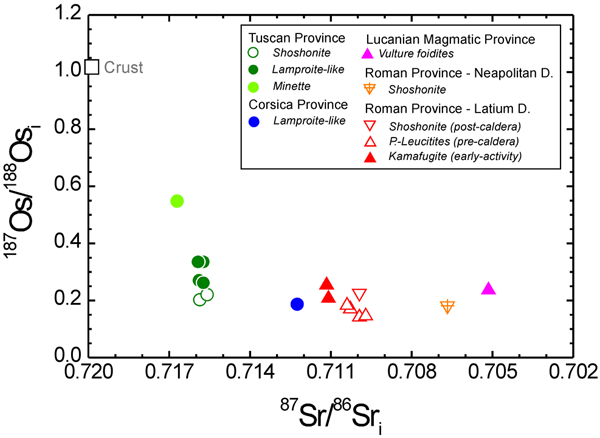Sr, Nd and Pb Isotopes
Italian ultrapotassic rocks and associated shoshonites, high-K calc-alkaline and calc-alkaline igneous rocks have extremely variable radiogenic isotope compositions (e.g., Tables 2-8), displaying a geographic variation firstly from West to East and later from North-West to South-West (see fig. 10 in Conticelli et al., 2007).
The observed isotope variation covers almost the entire spectrum of mantle and upper crustal values, complicating the interpretation of the petrogenetic grid of Italian ultrapotassic and associated shoshonites and calc-alkaline rocks (e.g., Hawkesworth & Vollmer, 1979; Vollmer & Hawkesworth, 1981; Vollmer, 1989; Conticelli et al., 2002, 2007; Gasperini et al., 2002; Bell et al., 2004; Martelli et al., 2004; Peccerillo, 2004; Avanzinelli et al., 2008).
87Sr/86Sri values range from 0.70522 for a basanite at Monte Vulture Volcano (Avanzinelli et al., 2008) to 0.71883 for the Rio Rechantez minette in the Western Alps Oligocene province (Owen, 2008); 143Nd/144Ndi values range from 0.512712 for a basanite at Monte Vulture Volcano (D’Orazio et al., 2007) to 0.511991 for the Rio Rechantez minette in the Western Alps Oligocene province (Prelevic et al., 2008; Conticelli et al., 2009a).
Initial 143Nd/144Nd values show a strong negative correlation with initial 87Sr/86Sr (Figs. 35, 36, and 37), although a decoupling of the correlation is observed between leucite-bearing and leucite-free trends (i.e., Conticelli et al., 2002). The most primitive rocks of each magmatic province define trends with isotopic values that vary regularly passing from ultrapotassic mafic terms to calc-alkaline ones through shoshonites (Figs. 35 and 36), with the former having the most crust-like values. A strong correlation between isotopic values and the abundances of K, Rb, Sr, Ba and most incompatible trace elements is present (Cox et al., 1976; Conticelli et al., 2009a).
Figure 36. Nd-Sr isotopic variations for the Amiata Volcano, Roman and Lucanian Magmatic provinces.
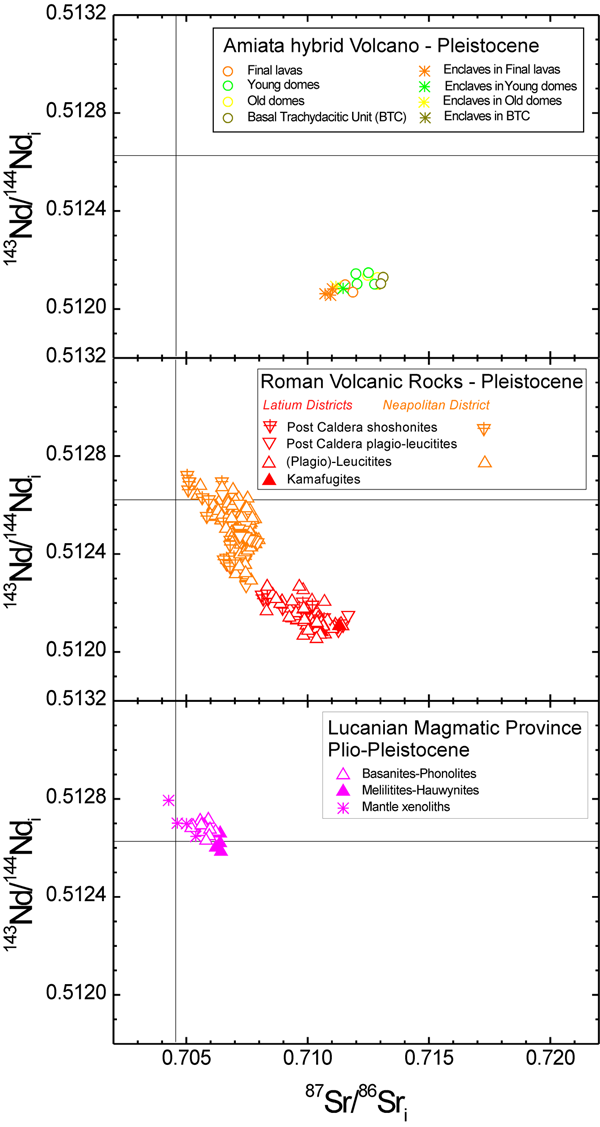
Data from Conticelli et al. (1987, 1991, 1997, 2002, 2007, 2009b), Ayuso et al. (1998), Pappalardo et al. (1999, 2002), D’Antonio et al. (1999b), Perini et al. (2000, 2003, 2004), Downes et al. (2002), Gasperini et al. (2002), De Astis et al. (2006), Di Rienzo et al. (2007), D’Orazio et al. (2007, 2008), Avanzinelli et al. (2008, 2010), Boari et al. (2009a,b), Conticelli’s unpublished data; Melluso’s unpublished data; Tommasini’s unpublished data.
Within the Roman Magmatic Province two different sectors can be distinguished based on radiogenic isotopes: the rocks from the districts of the northern sector (i.e., Latian districts: Vulsini, Vico, Sabatini, Colli Albani, Middle Latin Valley, and Roccamonfina; Figs. 1 and 11) show higher 87Sr/86Sri and lower 143Nd/144Ndi values relatively to the rocks of the Neapolitan district (Fig. 37), the southernmost cluster of volcanic apparata (Figs. 1 and 11). Post-caldera shoshonites and sub-alkaline rocks of the southernmost Latian district (i.e., Roccamonfina volcanoes) show intermediate values between Latian and Neapolitan rocks (Fig. 37).
Figure 37. Nd-Sr isotopic variations for the Roman Magmatic Provinces with fields for each single district.
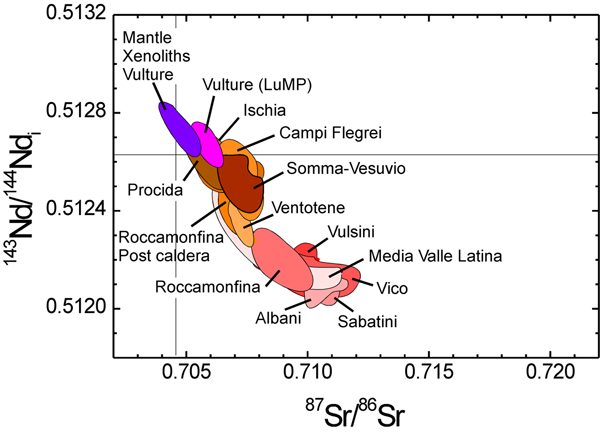
Data from Conticelli et al. (1987, 1991, 1997, 2002, 2007, 2009b), Ayuso et al. (1998), Pappalardo et al. (1999, 2002), D’Antonio et al. (1999b), Perini et al. (2000, 2003, 2004), Gasperini et al. (2002), Di Rienzo et al. (2007), Avanzinelli et al. (2008), Boari et al. (2009a,b), Tommasini’s unpublished data.
The same geographic variation can be onserved in Pb, Hf, and He isotopes. Lead isotopes display single correlation trends for each magmatic province with the ultrapotassic terms, either leucite-bearing or –free, at the most radiogenic end. Each trend runs parallel to the other ones (e.g., Conticelli et al., 2009b; Boari et al., 2009b) (Fig. 38); the trend of Western Alps Oligocene magmatic province lies at the lowest 206Pb/204Pbi values whilst that of the Lucanian Magmatic Province at the highest (Fig. 38).
Figure 38. 87Sr/86Sri, 143Nd/144Ndi, and 208Pb/204Pbi vs. 206Pb/204Pbi for the Italian ultrapotassic rocks.
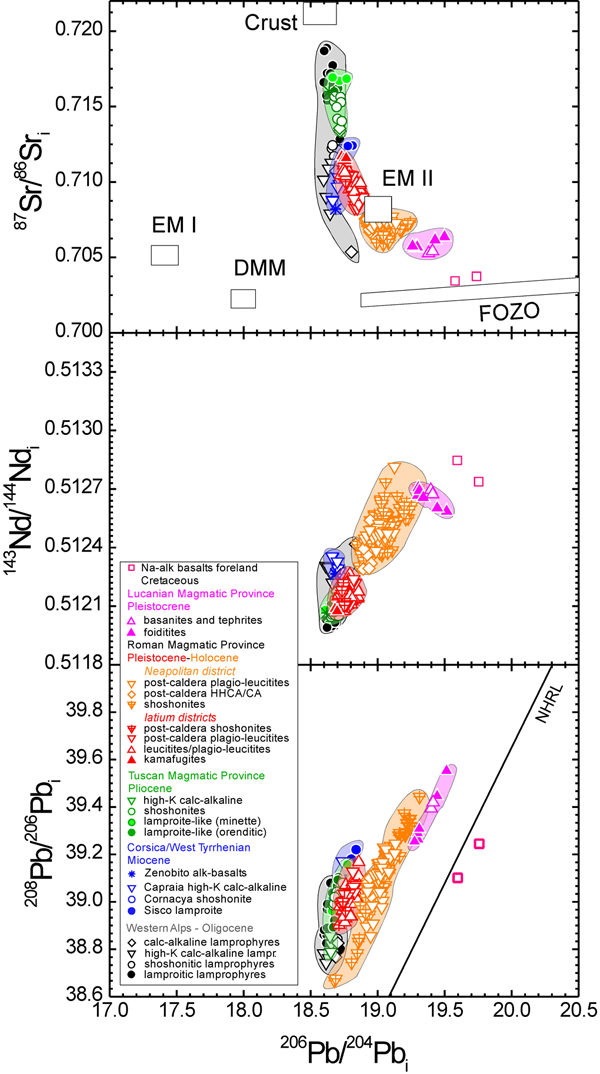
Data from Conticelli et al. (1987, 1991, 1997, 2002, 2007, 2009a, 2009b, 2010c, 2010d), Ayuso et al. (1998), Conticelli (1998), Pappalardo et al. (1999, 2002), D’Antonio et al. (1999b), Perini et al. (2000, 2003, 2004), Downes et al. (2002), Cadeaux et al. (2005), De Astis et al. (2006), Peccerillo & Martinotti (2006), Di Rienzo et al. (2007), D’Orazio et al. (2007, 2008), Owen (2007), Prelevic et al. (2008), Stoppa et al. (2008), Avanzinelli et al. (2008, 2010), Boari et al. (2009a,b), Cadeaux & Pinti (2009), Melluso’s unpublished data; Tommasini’s unpublished data.
The volcanic rocks of the of the Westrern Tyrrhenian Sea Magmatic Province (Corsican) represent an exception to the observed array of lead isotopes versus those of Strontium and Neodimium. Indeed the Corsican rocks depict opposite trends to those observed in the other magmatic provinces. Zenobito alkali basalts plot as an offset with respect to the Italian array (Fig. 38) toward the isotopic composition of Late/Middle Miocene-Quaternary volcanic rocks of Sardinia, and in general toward a depleted mantle source (e.g., Avanzinelli et al., 2009, and references therein). Bell et al. (2004) argued that the general trend of the Italian rocks points toward a FOZO component in the 87Sr/86Sri vs. 206Pb/204Pbi diagram (Fig. 38). Indeed, as a whole, Italian rocks fill the gap between upper crustal composition and FOZO (Hart et al., 1992) passing through the isotopic composition of EM II end-member (Zindler & Hart, 1986), which is believed to represent a recycled sedimentary component. In figure 38 most of Italian potassic and ultrapotassic products plot between upper crustal composition and EM II with the most ultrapotassic compositions (i.e., lamproite, kamafugite and leucitite) closest to thye upper crustal composition. FOZO isotope compositions are only approached by volcanic rocks from magmatic suites south of the 41st parallel, which also points toward the isotope composition of anorogenic cretaceous alkali basalts occurring on the Apulian foreland (Fig. 38). A less-depleted asthenospheric mantle source has been proposed for the southernmost sector of Italian magmatism (e.g., Beccaluva et al., 1991; Avanzinelli et al., 2009). Similar isotopic compositions are also reported for calc-alkaline rocks from the Aeolian Arc (e.g., Francalanci et al., 1993, 2007; Peccerillo, 2001, 2005a; Tommasini et al., 2007).
Evidence for a strongly anomalously enriched upper mantle for the source of ultrapotassic magmas is also highlighted by the values of 176Hf/177Hfi (Fig. 39), which vary from values typical of lamproitic magmatism (e.g., Prelevic et al., 2010) to values similar to astenospheric mantle reservoir in the region below the 41st parallel (i.e. Neapolitan district). Indeed, eHfT values are as low as -13 in lamproitic rocks from Western Alps, Western Tyrrhenian Sea, and Tuscany (Prelevic et al., 2010) increasing to values between -9 and -7 in shoshonitic rocks associated to lamproites (Gasperini et al., 2002; Prelevic et al., 2010), and between -8.1 and -6.2 in the leucite bearing rocks of the Latian districts of the Roman province (Gasperini et al., 2002), up to values of -0.5 and -0.2 for the rocks of the Neapolitan district (Gasperini et al., 2002; Tommasini’s unpublished data). A strong negative correlation between 176Hf/177Hfi and 87Sr/86Sri reinforce the hypothesis of the recycling of an upper crustal component in the mantle source of the ultrapotassic Italian magmas (e.g., Gasperini et al., 2002; Prelevic et al., 2010).
Figure 39. 176Hf/177Hfi vs. 87Sr/86Sri for the Italian ultrapotassic rocks.
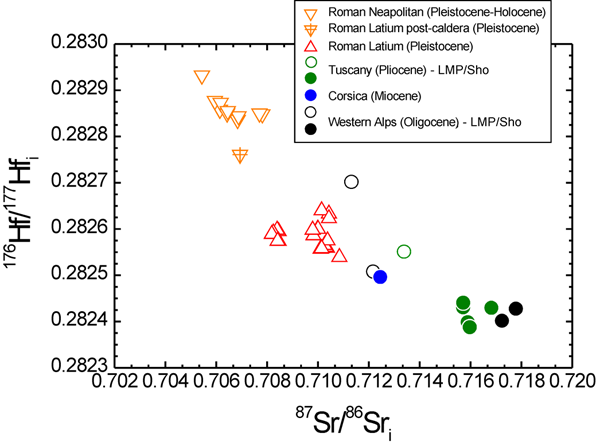
Data from Gasperini et al. (2002), Prelevic et al. (2010), Tommasini’s unpublished data.
He isotopes performed on fluid inclusions within olivine and clinopyroxene crystals from rocks of the Tuscan and Roman magmatic provinces (Martelli et al., 2004) add further constraints on the nature of the mantle sources of these magmas. 3He/4He values are significantly lower than MORB and display a negative correlation with 87Sr/86Sr (measured either on whole rocks or clinopyroxene crystals). Martelli et al. (2004) suggested the occurrence of a binary mixing between an asthenospheric component, similar to an HIMU ocean island basalt, and an enriched in radiogenic isotopes upper mantle component, metasomatised with recycled sediments.
Recycled sediments within the upper mantle source of ultrapotassic magmas has been also pointed out on the basis of 187Os/188Osi vs. 87Sr/86Sri values (Fig. 40). Indeed, significant amounts of recycled crustal material (up to 65% for the most enriched lamproites of the Tuscan Magmatic Province) within the upper mantle source are required for the genesis of ultrapotassic lamproitic and kamafugitic magmas (Conticelli et al., 2007).
